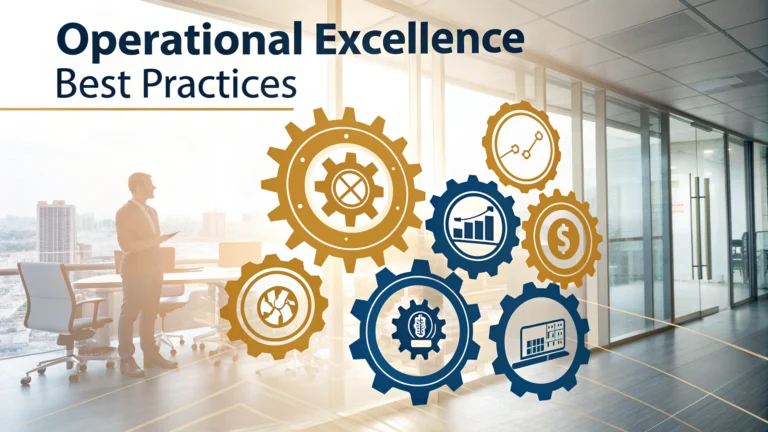Operational excellence drives sustainable growth and competitive advantage in organizations through systematic process improvements and standardization.
This guide outlines proven strategies that chief operating officers can implement to achieve and maintain operational excellence across their organizations.
By following these best practices, COOs can optimize performance, reduce costs, and create a culture of continuous improvement.
Core Principles of Operational Excellence
- Process standardization and documentation
- Data-driven decision making
- Continuous improvement mindset
- Employee engagement and empowerment
- Customer-centric focus
Key Implementation Steps
Start by conducting a thorough assessment of current operations to identify areas for improvement.
Establish clear metrics and KPIs to measure operational performance.
Develop standardized processes and procedures across all departments.
Implement regular training programs to ensure consistent execution.
Technology and Tools
- Process Mapping Software: Lucidchart, Microsoft Visio
- Project Management Tools: Monday.com, Asana, Jira
- Analytics Platforms: Tableau, Power BI
- Quality Management Systems: ETQ, MasterControl
Performance Measurement Framework
| Category | Key Metrics |
|---|---|
| Quality | Defect rates, customer satisfaction scores |
| Efficiency | Cycle time, resource utilization |
| Cost | Operating expenses, cost per unit |
| Safety | Incident rates, compliance scores |
Employee Engagement Strategies
- Regular training and skill development programs
- Clear career progression paths
- Recognition and reward systems
- Open communication channels
- Cross-functional team collaboration
Risk Management
Implement a robust risk assessment and mitigation strategy.
Regular audits and compliance checks help maintain operational standards.
Develop contingency plans for potential operational disruptions.
Building Long-term Success
Document and share best practices across the organization.
Foster a culture of innovation and continuous improvement.
Regularly review and update operational strategies based on performance data.
For additional guidance, contact the Association for Operations Management (APICS) at www.apics.org or call 1-800-444-2742.
Change Management Strategy
Successful operational excellence requires effective change management to overcome resistance and ensure adoption.
- Clear communication of goals and benefits
- Stakeholder engagement at all levels
- Phased implementation approach
- Regular feedback collection and adaptation
- Leadership support and visibility
Quality Assurance Systems
Process Control Methods
- Statistical process control (SPC)
- Six Sigma methodologies
- Quality control checkpoints
- Automated inspection systems
Documentation Requirements
- Standard Operating Procedures (SOPs)
- Work Instructions
- Quality Manual
- Compliance Records
Continuous Improvement Cycle
Implement PDCA (Plan-Do-Check-Act) methodology across all improvement initiatives:
- Regular performance reviews
- Root cause analysis
- Corrective action implementation
- Results validation
Maximizing Operational Success
Sustainable operational excellence requires commitment to long-term vision and continuous adaptation to changing business environments.
Organizations must maintain focus on both immediate operational efficiency and strategic growth objectives.
Regular benchmarking against industry standards ensures competitive positioning and identifies new improvement opportunities.
Success depends on the integration of people, processes, and technology working together toward common operational goals.
FAQs
- What are the key components of Operational Excellence?
Leadership, continuous improvement, process optimization, employee empowerment, standardization, performance metrics, and waste elimination. - How do you measure Operational Excellence success?
Through KPIs including productivity rates, quality metrics, customer satisfaction scores, cycle time, cost reduction, employee engagement levels, and process efficiency ratios. - What role does Six Sigma play in Operational Excellence?
Six Sigma provides a structured methodology (DMAIC) to reduce process variation, eliminate defects, and improve quality through data-driven decision making. - How does Lean methodology contribute to Operational Excellence?
Lean focuses on eliminating waste, improving flow, reducing inventory, and creating value-added processes while minimizing non-value-added activities. - What is the significance of Standard Operating Procedures (SOPs) in Operational Excellence?
SOPs ensure consistency, reduce errors, facilitate training, and create a foundation for continuous improvement through documented best practices. - How does technology enable Operational Excellence?
Technology automation, data analytics, process monitoring systems, and digital transformation tools enhance efficiency, visibility, and decision-making capabilities. - What is the role of employee training in Operational Excellence?
Regular training develops workforce capabilities, ensures compliance, promotes problem-solving skills, and enables continuous improvement culture. - How can organizations sustain Operational Excellence initiatives?
Through leadership commitment, regular audits, performance tracking, employee engagement, continuous feedback loops, and systematic review processes. - What is the connection between Quality Management and Operational Excellence?
Quality Management provides frameworks and tools to ensure consistent product/service quality while supporting continuous improvement efforts. - How does Change Management support Operational Excellence?
Change Management ensures successful implementation of improvement initiatives through stakeholder engagement, communication, and resistance management.
